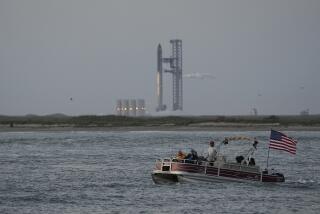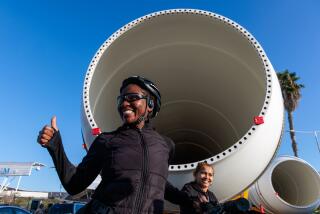Rocket Blueprint
Next summer, Brian Walker hopes to launch his 24-foot homemade rocket 35 miles above the Earth’s surface--with him on board. He expects the trip to last 15 to 20 minutes. Here’s how it’s supposed to work:
* The rocket’s 9,000-pound load of 90% pure hydrogen peroxide will be forced from a pressurized fuel tank into a catalyst chamber containing stacks of silver screens. Contact with the silver will create a chemical reaction, causing the hydrogen peroxide to suddenly expand. That will create a burst of steam providing the needed thrust.
* An engine at the base of the fuel tank will produce 12,000 pounds of thrust, and since the rocket will consume 90 pounds of fuel per second, it will continue to accelerate for about 100 seconds.
* Six small thrust motors at the base of the capsule will be used to separate the command capsule when the main fuel tank is exhausted. They can also be fired in the event of an emergency, allowing a parachute to be deployed.
* Eight thrust motors in the nose of the capsule will be fired to keep the capsule pointed straight up.
* Walker will guide the rocket with only a throttle.
* The fuel in the thrusters will empty roughly 20 miles into the stratosphere. The main engine, along with the fuel tank, will be jettisoned and guided back to Earth on a parachute-style wing controlled from the ground by an assistant.
* The capsule will hurtle upward at about four times the speed of sound before coming to a stop. Walker will feel several seconds of weightlessness as the capsule tips back toward Earth.
* A small parachute will deploy, and retrorockets will fire, slowing the capsule’s descent. Wearing a parachute and a Russian space suit, Walker will be able to eject if necessary.
* At about 12,000 feet, a large parachute wing will deploy to guide the capsule back to the desert.
* Walker’s ground crew will have telemetry equipment and be able to land the craft in the event that he is not conscious.
More to Read
Sign up for Essential California
The most important California stories and recommendations in your inbox every morning.
You may occasionally receive promotional content from the Los Angeles Times.










